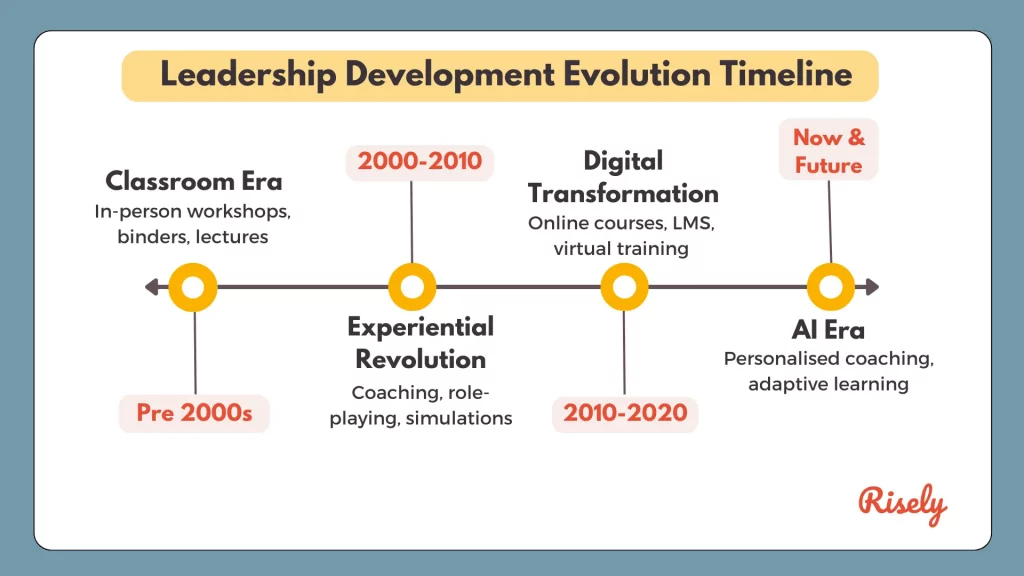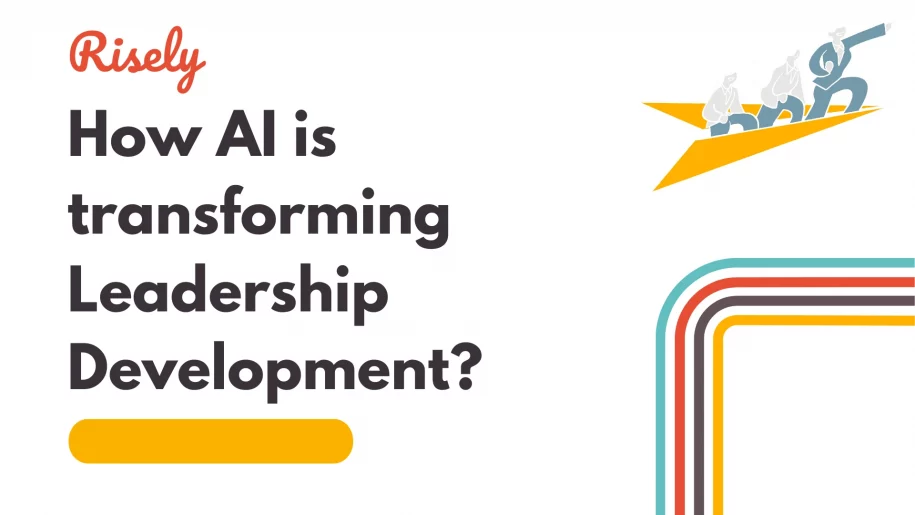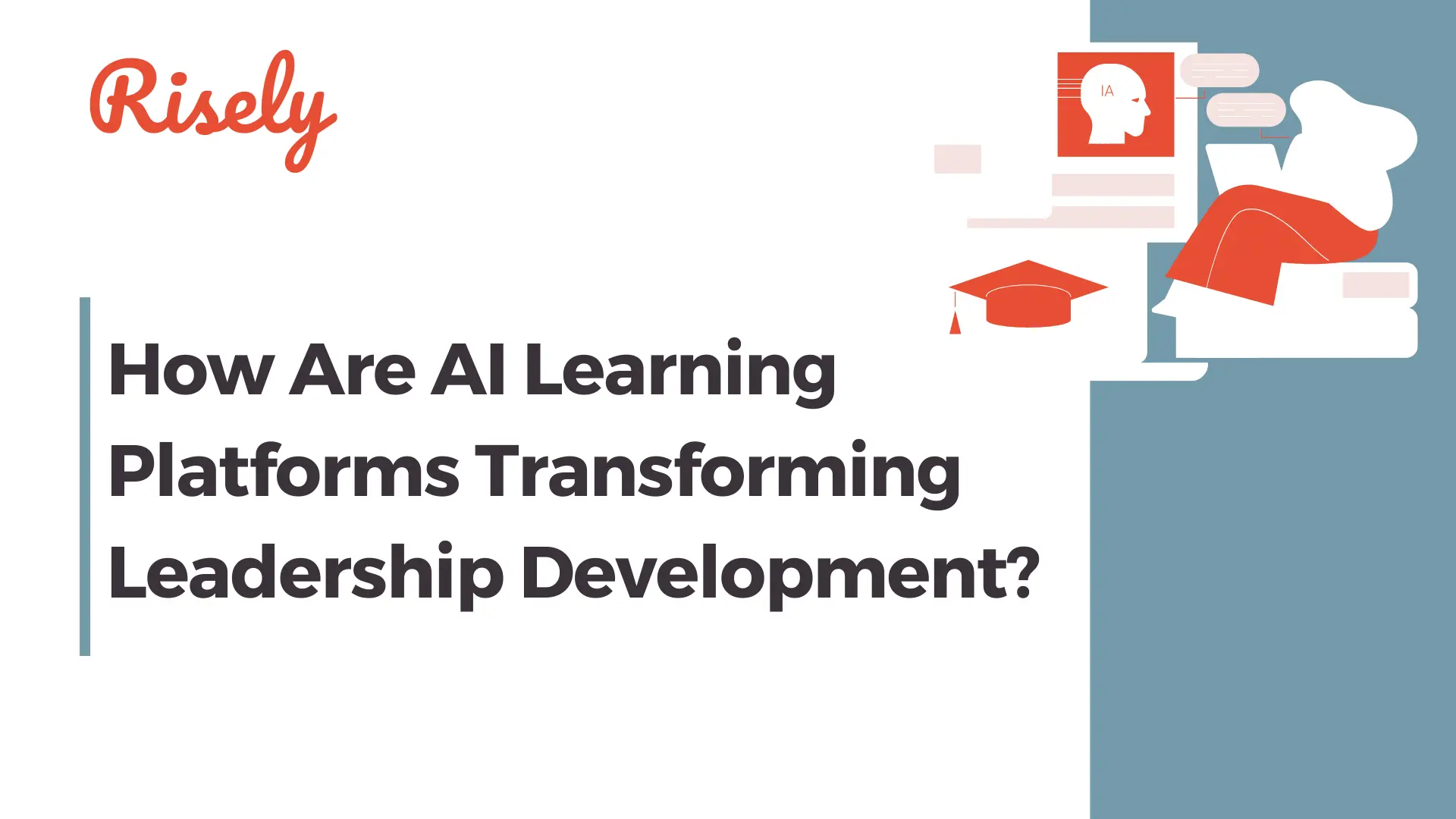AI and Leadership Development: Driving Synergy for Growth
You know the frustration all too well. Your organization invests thousands in leadership development programs, yet three months later, those workshops feel like distant memories. A study by the Center for Creative Leadership(1) highlighted that only 11% of organizations feel confident in their leadership pipeline to fill critical roles. You’re still trying to offer one-size-fits-all training across multiple levels, when each leader has unique needs. Whether it’s managing hybrid teams, building inclusive leadership skills, or managing performance during uncertainty, traditional training doesn’t cut it. But AI brings something new to the table. Instead of a one-size-fits-all approach, AI can customize learning for each person and keep adjusting as things change. It helps fill the gaps left by traditional training. Blending AI and leadership development is not just about being more efficient, it’s about giving each leader a personalized experience that leads to real, lasting growth. Let’s take a closer look at how these AI tools can transform your leadership development strategy.How Leadership Development Has Evolved From Classrooms to Algorithms?
70% of traditional leadership programs fail to produce lasting behavior change. This statistic from Harvard Business review(2) has haunted L&D professionals for decades, despite continuous evolution in development approaches. As we trace the journey from classrooms to algorithms, you’ll discover why AI and leadership development together might finally break this frustrating cycle.The Leadership Development Timeline
The Leadership Development Timeline tracks the shift from traditional classroom training to the present where AI and leadership development is becoming the norm, showing how leadership growth has evolved over time.
The Classroom Era
Remember when leadership development meant two days in a hotel conference room with binders of information? These traditional programs excelled at knowledge transfer but rarely translated into behavioral change. Why? Because knowing leadership principles doesn’t automatically make someone lead differently on Monday morning.The Experiential Revolution
Recognizing this gap, you likely shifted toward experiential learning and coaching in the 2000s. Role-playing, simulations, and one-on-one coaching created more engaging experiences with better application. The downside? These high-touch approaches proved difficult to scale across your organization.The Digital Transformation
Enter digital learning platforms, your attempt to scale quality development to all leaders. These systems democratized access but often created one-size-fits-all experiences that lacked the personalization of coaching and the engagement of experiential learning.It’s still not enough: do you know why?
Think of this evolution like transportation progress. Classroom training got leaders to their destination (slowly, like walking). Experiential learning moved faster (like horses) but couldn’t serve everyone. Digital platforms scaled (like early automobiles) but followed fixed routes regardless of individual needs. Despite these advancements, traditional leadership development consistently fails because it:- Happens outside the workflow, creating a transfer problem
- Lacks personalization to individual leader’s challenges
- Provides insufficient practice opportunities
- Offers limited feedback for continuous improvement
The AI and Leadership Development Era offers something more
AI-powered leadership development addresses these fundamental challenges by:- Personalizing at scale: Creating adaptive learning paths based on each leader’s strengths, weaknesses, and role-specific needs
- Learning in flow of work: Delivering micro-interventions precisely when leaders need guidance on real challenges
- Enabling continuous practice: Providing realistic simulations and scenarios for deliberate practice
- Offering instant, real time feedback: Analyzing communication, decisions, and behaviors to guide improvement
5 Ways AI and Leadership Development are Blending In
Leadership development is the process of enhancing an individual’s ability to perform in a leadership role within an organization. It is supposed to help managers grow, make better decisions, and handle challenges with confidence. But let’s be honest, most program knowledge doesn’t retain with the managers. They sit through a workshop, take notes, and then real-life happens, and they are on their own. The problem? Training isn’t personalized, and there’s no support when you actually need it. That’s where AI and leadership development step in; offering real-time, tailored coaching that helps leaders in the moment, not months later. Lets discuss how AI integration can help you design effective training programs for your managersHyper-Personalization at Scale: The End of One-Size-Fits-All Development
Remember when one generic program was made for all managers which yielded no value at all, but now with AI you can hyper personalize your training programs in accordance with needs of individual managers. By analyzing interaction patterns, performance data, and even communication styles, AI creates truly individualized learning journeys for each leader. Platforms like Risely can assess a manager’s specific challenges, whether handling conflict or strategic thinking, and generate a unique development pathway that adapts as they progress. What does a unique development pathway really mean? Learning with platforms like Risely is personalized at multiple levels:- It matches role and function,
- It tailors the content to their language preferences, and
- It aligns with their specific skill needs.
Just-in-Time Support: Meeting Leaders Where They Are
Leadership challenges don’t conveniently arise two weeks after the training workshop. They happen in the moment when your managers are facing a difficult conversation or making a crucial decision. Managing a team isn’t easy, there’s no pause button when tough situations come up. Waiting for a coaching session isn’t always an option, but AI coaches are there 24/7, ready to give quick, personalized advice right when you need it. Whether it’s handling a tricky conversation or making a big decision, AI helps managers stay confident and move forward in the moment. AI coaches like Risely’s Merlin deliver contextual guidance precisely when needed. Preparing for a performance review with a struggling team member? Merlin can provide tailored talking points and strategies moments before the meeting. This approach of AI and leadership development works perfectly with our brains as immediate application rather than delayed recall. Your leaders receive support when their motivation to learn is highest, that is when facing a real challenge.Practice-Based Learning: Safe Spaces for Skill Development
AI creates consequence-free environments where leaders can practice crucial skills through realistic simulations. For example, Risely’s role-play scenarios allow managers to try different approaches to sensitive situations, receiving immediate feedback on their choices. AI and leadership development can be combined to create similar win-win situations.Data-Driven Development: Moving Beyond Gut Feelings
How many leadership development decisions start with subjective impressions rather than objective data? AI analyzes patterns across interactions, decisions, and outcomes to identify true development priorities. This leads us to features like Risely’s skill center, that provides self assessments and it also combines anonymous reviews from team members of the managers. This means you can finally connect specific leadership behaviors to business outcomes, proving the ROI of your development initiatives. AI and leadership development, thus, make you more data driven.Democratizing Coaching: Making Expert Guidance Accessible
Executive coaching works wonders, but at $500+ per hour, it’s typically reserved for the C-suite. AI and leadership development can change this equation dramatically. By making personalized coaching available at a fraction of the cost, platforms like Risely extend these benefits throughout your leadership pipeline. Your frontline supervisors, who often impact the most employees directly, can now receive the same quality of guidance as your executives. Democratizing coaching isn’t just about making it accessible to more people, it’s also about reaching leaders who may not be comfortable with English. AI-powered platforms can adapt to different languages and communication styles, ensuring that all leaders, regardless of their background, can benefit from expert coaching and development. AI isn’t replacing leadership development, it’s transforming it from a periodic event into a continuous, personalized journey for every leader in your organization.Where to Start Implementing AI and Leadership Development?
What separates the successes from the struggles? The answer lies not in the technology itself, but in how strategically you approach implementation.Is Your Organization Ready for AI-Driven Leadership Development?
Before investing in AI and leadership development solutions, you need to honestly assess if your organization is truly prepared for this transformation. This goes beyond your technical infrastructure to include your people and processes. Ask yourself: Does your leadership team genuinely understand and support AI-enhanced development? Many executives say they want AI, but do they understand what that means for how leaders will be developed in your organization? Your data infrastructure is equally crucial. AI systems thrive on high-quality data, so consider: What leadership data do you currently collect? Is it comprehensive, accurate, and structured enough to fuel meaningful AI insights? Without solid data foundations, even the most sophisticated AI tools will deliver disappointing results. Your L&D team’s readiness matters too. Do your learning professionals have the skills to effectively partner with AI systems? Can they interpret AI-generated insights and translate them into meaningful development experiences? Consider forming a cross-functional AI readiness team that includes stakeholders from L&D, IT, legal, and executive leadership. This diverse perspective will help you identify readiness gaps you might otherwise miss on AI and leadership development.Change Management: The Hidden Success Factor
Even perfect AI and leadership development solutions fail without effective change management. Your leaders may naturally question AI-driven feedback or worry about how their data will be used. To address this, develop a clear communication strategy that anticipates concerns and showcases early wins. Explaining how AI will enhance (not replace) human coaching relationships is particularly important for gaining buy-in. Consider starting with a pilot program targeting tech-forward leaders who can become your internal champions. Their positive experiences and testimonials will be invaluable when you expand to broader leadership populations who may be more skeptical.Determining integration points with existing L&D infrastructure
AI and leadership development solutions should enhance your current ecosystem, not replace it entirely. Map your existing leadership development journey and identify specific points where AI can add value:- Pre-assessment and skills gap analysis
- Personalized learning path creation
- Practice environments for leadership scenarios
- Real-time feedback during leadership challenges
- Development progress tracking and recommendation engines.
Building the business case for AI investment in leadership development
When seeking budget approval for AI and leadership development, focus on outcomes rather than features. Quantify potential impacts such as:- 30% reduction in leadership program development time
- 42% improvement in leadership skill application post-training
- 25% decrease in high-potential turnover through improved development experiences
Selecting the Right AI Leadership Development Solution
With your readiness assessment complete, you can now evaluate specific solutions against well-defined criteria.Evaluation criteria for AI leadership platforms
Develop a weighted scoring system that reflects your organizational priorities:- Alignment with your leadership competency framework (is it configurable?)
- Sophistication of analytics and insight generation
- Quality and breadth of content library or content generation capabilities
- Personalization capabilities at individual and cohort levels
- Evidence of impact and case studies from similar organizations
- Implementation support and change management resources
- Total cost of ownership (beyond initial licensing)
Balancing technological sophistication with user experience
Remember that the most advanced AI isn’t necessarily the best choice if your leaders won’t use it. Evaluate solutions from the user perspective:- How intuitive is the interface for time-constrained leaders?
- Can leaders access development resources in their workflow?
- Does the AI communicate in ways that feel supportive rather than judgmental?
- How much time is required from leaders to see meaningful insights?
Integration capabilities with existing systems
Ensure your AI and leadership development solution can connect with:- Your HRIS and talent management systems
- Performance management platforms
- Learning management systems
- Communication tools (Teams, Slack, etc.)
- Succession planning frameworks
Data privacy and ethical considerations
This is non-negotiable territory if you are thinking of AI and leadership development. Scrutinize:- Data collection practices and transparency
- Leader control over personal data
- Algorithmic bias detection and mitigation
- Compliance with regional regulations (GDPR, etc.)
- Ethical use of behavioral and performance data
Measuring the Impact of AI-Powered Leadership Development
Your measurement strategy should be defined before implementation of AI and leadership development, not as an afterthought.Moving beyond satisfaction scores to behavioral change metrics
Traditional evaluation metrics like completion rates and satisfaction scores provide incomplete pictures of impact. Instead while thinking of AI and leadership development, focus on:- Observable leadership behavior changes (measured through 360 feedback)
- Application frequency of specific leadership skills
- Quality of leader-team interactions (via team engagement data)
- Decision-making effectiveness in leadership scenarios
- Developmental velocity (time to proficiency in new leadership skills)
Connecting leadership development to business outcomes
The ultimate justification for your AI and leadership development investment comes from business impact. Work with finance and operations teams to correlate leadership development with:- Team performance metrics
- Employee engagement and retention
- Innovation outputs
- Customer satisfaction scores
- Succession pipeline strength
Creating feedback loops for continuous improvement
AI and leadership development systems improve through data. Establish mechanisms to:- Gather regular feedback from leaders on AI recommendations
- Track which development resources lead to measurable behavior change
- Identify gaps in the AI’s leadership development approach
- Continuously update your leadership competency models based on evolving business needs
Establishing realistic timelines for measuring ROI
Leadership development has always been a long game—adding AI doesn’t change this fundamental truth. Set appropriate expectations:- Short-term metrics (0-3 months): Adoption, engagement, satisfaction
- Medium-term metrics (3-9 months): Behavior change, skill application
- Long-term metrics (9+ months): Business impact, succession strength
Is AI going to replace the human element in leadership development?
This question keeps many of you up at night. Let’s address these concerns head-on.The Human Touch
You might worry that AI could make leadership development feel impersonal. In reality, AI takes over repetitive tasks like content personalization and skills assessment, allowing L&D leaders to focus on what truly matters, building strategy, securing stakeholder buy-in, and driving business impact. AI doesn’t replace the human element; it empowers L&D leaders to make more strategic decisions and create high-impact development experiences.Perceiving AI as “Complex”
“I’m not a tech person” shouldn’t stop you from utilizing AI. AI Learning platforms feature intuitive interfaces designed specifically for L&D professionals, not engineers. Think of using modern AI like using a smartphone—the complex technology is hidden behind a user-friendly experience.AI with Transparency
Modern AI and leadership development platforms increasingly offer transparency into their recommendations. They’ll explain why they’ve suggested specific training and development plans for leaders, allowing you to validate or adjust suggestions based on your expertise.AI: Here to Automate, Not Replace You
AI isn’t developing robot-like leaders, quite the opposite. By handling administrative aspects of development, AI allows programs to focus more deeply on uniquely human skills like empathy, ethical decision-making, and inspirational communication. Start small. Integrate AI in one aspect of your leadership development program and watch the human elements flourish, not diminish.Key Takeaways
- Your leaders need guidance in their moments of uncertainty, not just during training, AI’s real-time coaching capabilities fill this crucial gap when you can’t be there personally.
- Start with a focused approach: identify your most pressing leadership challenge and pilot an AI solution there first, measuring results before scaling.
- The insights you’ll gain will transform your strategy—imagine knowing exactly which leadership interventions drive behavior change and which are just “nice to have.”
- Your role becomes more strategic with AI handling the heavy lifting of content creation and personalization, freeing you to focus on organizational alignment and executive buy-in.
- Remember that blending AI with human wisdom creates the magic—technology amplifies your expertise rather than replacing the human connection leaders crave.
References
- Center for Creative Leadership Report on Leadership Development
- Harvard Business Review Article on Change Management
Ready to Take Your Training Programs to the Next Level?
Transform your training programs with personalized, AI-driven solutions. Start your journey with Risely today!
How Are AI Learning Platforms Transforming Leadership Development?
How Are AI Learning Platforms Transforming Leadership Development? As an L&D leader, you’re likely familiar with this frustrating reality: 82%…
5 Essential AI Skills for L&D Leaders
5 Essential AI Skills for L&D Leaders According to LinkedIn’s 2025 Workplace Learning Report(1), 71% of L&D professionals are now…
How to Create a Course with AI: A Guide for L&D Professionals
How to Create a Course with AI: A Guide for L&D Professionals According to a McKinsey survey(1), only 11% of…
Building an Ultimate Leadership Development Action Plan
How to Build a Leadership Development Action Plan? Having a strong Leadership Development Action Plan is more critical than ever…
How to build a Learning and Development Action Plan ft Katie Greenwood
How to build a Learning and Development Action Plan ft Katie Greenwood Does your company’s Learning and Development (L&D) strategy…


